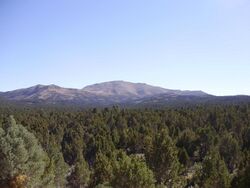Biology:Pinyon–juniper woodland

Pinyon–juniper woodland, also spelled piñon–juniper woodland, is a biome found at higher elevations near deserts in the Western United States, characterized by being an open forest dominated by low, bushy, evergreen junipers, pinyon pines, and their associates which vary from region to region.[1][2] The woodland's density and crown height varies dramatically, with mature trees ranging in height from as low as 2 meters[3] up to 15 meters.[4] At lower elevations, junipers often predominate and trees are spaced widely, bordering on and mingling with grassland or shrubland. As elevation increases, pinyon pines become common and trees grow closer, forming denser canopies.[3] Historically, pinyon-juniper woodland has provided a vital source of fuel and food (particularly piñon nuts) for peoples of the American Southwest.[1][3]
Subtypes
Pinyon-juniper woodland has three major subtypes based on vegetation: pinyon-juniper savannah, pinyon-juniper wooded shrubland, and pinyon-juniper persistant woodland.[2]
- Pinyon-juniper savannahs are dominated by grasses and forbs, with dense undergrowth and savannah-like sparser trees. Monsoon summer rains are common in pinyon-juniper savannahs, since they favor the growth of warm-season grasses. Common grass species are blue grama, other species of grama grass, new mexico muhly, curlyleaf muhly, and needle and thread grass.
- Pinyon-juniper persistent woodlands are dominated by trees, with a variety of tree ages, often in areas with winter or bi-modal precipitation. Persistent woodland sites are usually unproductive, with thin soils and sparse ground or shrub cover, often occurring on rocky or rugged terrain.
- Pinyon-juniper wooded shrublands are transition zones where pinyon-juniper woodland is expanding or contracting, often bordering other vegetation types. In absence of fire, they shift from grass and forb-dominated, to shrub-dominated, to tree-dominated communities over time. Common shrub species are big sagebrush, other species in that genus, antelope bitterbrush, rabbitbrush, mountain mahogany, and snakeweed.
Range
File:Pinyon-juniper woodland.tiff
Arizona and New Mexico
The pinyon–juniper woodland is one of the most prevalent types of coniferous woodland in northern Arizona and New Mexico.[5] In Arizona the great basin woodland species are Juniperus arizonica, Juniperus californica in western Arizona, Juniperus deppeana, Juniperus monosperma, Juniperus osteosperma, Juniperus scopulorum at higher elevations, Pinus monophylla var. fallax below the Colorado plateau, and Pinus edulis on the Colorado plateau.[6][better source needed] In Arizona the great basin woodland includes many species of oaks: Quercus turbinella, Quercus gambelii at higher elevations, Quercus grisea, Quercus arizonica, and Quercus emoryi.[7][better source needed] In Southern Arizona, Pinus discolor, Juniperus deppeana, and Pinus leiophylla make up the conifer woodland with many oak species.[8][better source needed]
Utah and Canyonlands region
The pinyon–juniper plant community covers a large portion of Utah and the Canyonlands region. Singleleaf ash (Fraxinus anomala), and Utah serviceberry (Amelanchier utahensis) are codominants of pinyon pine and Utah juniper. In this region, the community occurs on rocky soils or jointed bedrock.[9][better source needed]
Mojave Desert
In the steppes adjoining the Mojave Desert, this vegetation type can be found in areas receiving 12–20 inches of annual precipitation, and between 4,500 and 8,000 feet.[10][better source needed] Associates include bitterbrush (Purshia glandulosa), Apache plume(Fallugia paradoxa), desert sagebrush (Artemisia tridentata), green ephedra (Ephedra viridis), mountain mahoganies (Cercocarpus spp.), and buckwheats (Eriogonum spp.).[10][better source needed] In the Mojave, pinyon–juniper woodlands are generally above the Joshua Tree woodlands vegetation type, and requires more annual precipitation.[10][11]
Sierra Nevada
In the eastern Sierra Nevada, the elevation range is 4,000-5,500 feet in the north, and 5,000 to 8,000 feet in the southern reaches of the range. Pinyon–juniper woodland requires 12–20 inches of annual precipitation, so is generally located above the sagebrush scrub vegetation type, which can survive on an average of 7 inches per year. It is located below the alpine zone. There is often an understory dominated by sagebrush (Artemisia tridentata) and its associates. Co-dominants include Jeffrey Pine (Pinus jeffreyi) and an understory of sagebrush scrub or rabbitbrush scrub (Ericameria spp.).[12][better source needed]
See also
References
- ↑ 1.0 1.1 "Pinyon-Juniper Woodland". Habitats Alive!. California Institute for Biodiversity. 6 September 2012. ISBN 978-0971125919.
- ↑ 2.0 2.1 Cite error: Invalid
<ref>tag; no text was provided for refs named:0 - ↑ 3.0 3.1 3.2 Muldavin, Esteban; Triepke, F. Jack (1 July 2019). "North American Pinyon–Juniper Woodlands: Ecological Composition, Dynamics, and Future Trends". North American Pinyon' Juniper Woodlands: Ecological Composition, Dynamics, and Future Trends. pp. 516–531. doi:10.1016/B978-0-12-409548-9.12113-X. ISBN 9780128160978. https://par.nsf.gov/servlets/purl/10161464. Retrieved 5 February 2022.
- ↑ "Pinyon–juniper ecosystem". http://mojavedesert.net/habitat/pjn.html.
- ↑ Dick-Peddie, (1999) pp. 87.
- ↑ "Pinus monophylla (Singleleaf piñon) description - the Gymnosperm Database". https://www.conifers.org/pi/Pinus_monophylla.php.
- ↑ "SEINet Portal NetworkResearch Checklist: Sedona/Oak Creek Canyon". http://swbiodiversity.org/seinet/checklists/checklist.php?pagenumber=1&clid=105&dynclid=0&pid=1&searchsynonyms=1.
- ↑ "SEINet Portal NetworkResearch Checklist: Chiricahua National Monument". http://swbiodiversity.org/seinet/checklists/checklist.php?clid=25&pid=1.
- ↑ Damian Fagan, Canyon Country Wildflowers, p. 3
- ↑ 10.0 10.1 10.2 Pam MacKay, Mojave Desert Wildflowers, p19-20
- ↑ Adrienne Knute, Plants of the East Mojave, p31.
- ↑ Karen Wiese, Sierra Nevada Wildflowers, 2013, p. 18
Sources
- Dick-Peddie, William A. (1999). New Mexico Vegetation: Past, Present, and Future. University of New Mexico Press. pp. 280. ISBN 0-8263-2164-X.
- Cronquist, Arthur; Arthur H. Holmgren; Noel H. Holmgren; James L. Reveal; James Reveal; Noel Holmgren (1972). Intermountain Flora - Vascular Plants of the Intermountain West, U.S.A. - Geological and Botanical History of the Region, its Plant Geography and a Glossary. Vol. 1. The New York Botanical Garden Press. pp. 270. ISBN 0-89327-300-7.




